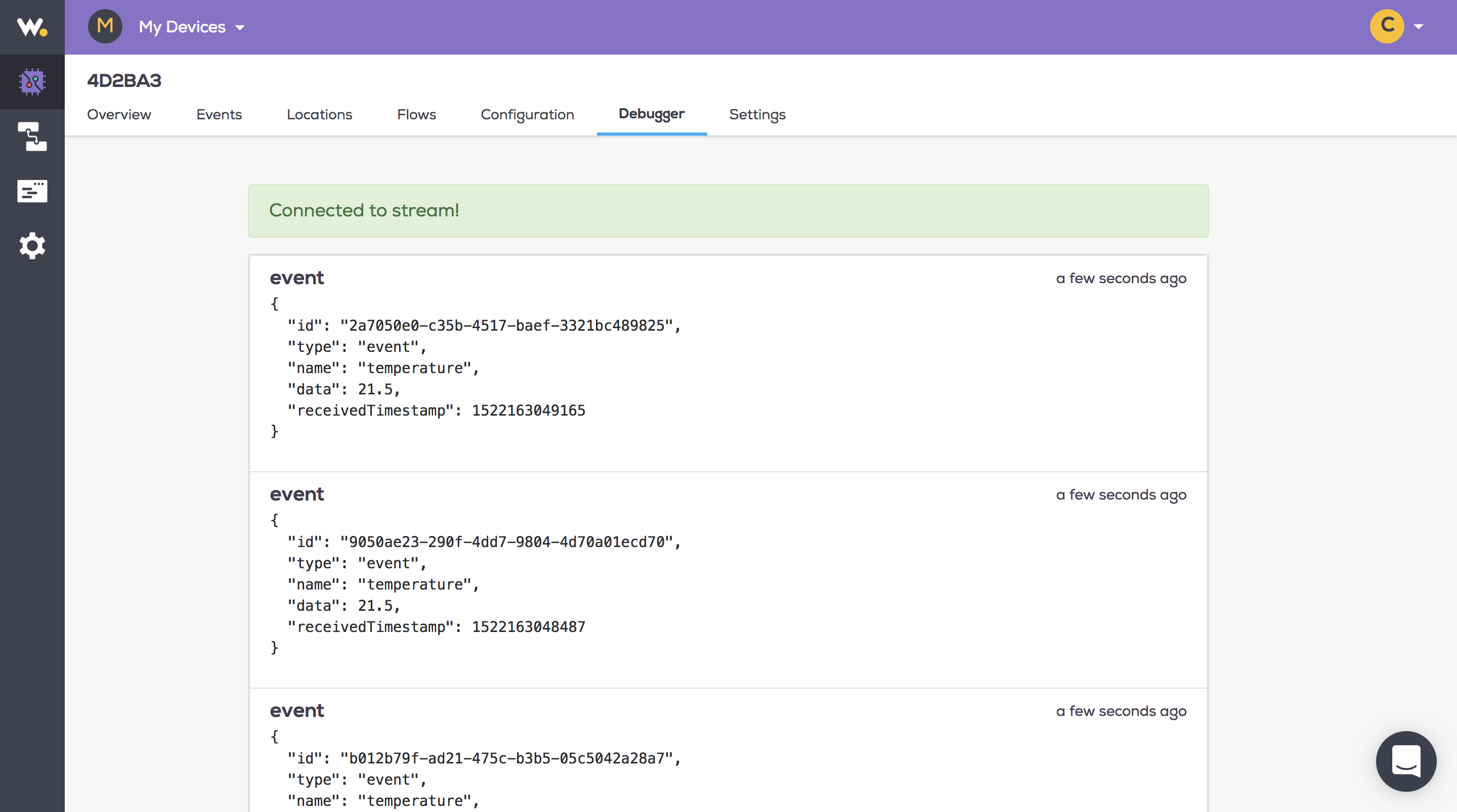Publish an Event with ESP8266 to Wia via CoAP API

Austin Spivey
Posted on June 18, 2018
In this tutorial, we'll go through setting up an ESP8266 board, and publish an event to Wia via our CoAP API.
Connecting the board
Note: If your board has a micro USB port, you can probably skip this step.
Connect your board to laptop/desktop via a USB to TTL cable/adapter. Here's a pinout showing the different connections.
Connections between the ESP and USB TTL are the following:
- ESP8266 <-> USB TTL
- GND <-> GND
- TX <-> RX
- VCC <-> 3.3V(+)
- CH_PD <-> 3.3V(+)
- GPIO0 <-> GND (Only while flashing the board)
Setup Your Environment
- Install the Arduino IDE. You can download it for Mac OS X, Windows and Linux here
- Start the Arduino application and open
Preferences - Enter
http://arduino.esp8266.com/stable/package_esp8266com_index.jsoninto the Additional Board Manager URLs. If you need more than one, they can be separated with commas
- Go to
Tools > Board > Boards Manager - Search for
esp8266. When found, clickInstall
Select your ESP8266 board type by going to Tools > Board, then choosing your type. For this example I am using NodeMCU 1.0 (ESP-12E Module).
You can get the name of your device's port using one of the following steps:
Linux and Mac OS X
- Download and install the FTDI drivers from here. Select the appropriate version for your operating system and architecture
- Open a terminal window and run the command
ls /dev/tty* - Look for a device with the name that begins with
/dev/ttye.g./dev/tty.usbmodemPy343431on MAC or/dev/ttyUSB0/dev/ttyACM0on Linux
Note:
For Linux, you may need to run the two commands below. Once you've completed that, reboot your computer. This will add permissions that will allow you to upload a sketch to the board.
sudo usermod -a -G tty ${USER}
sudo usermod -a -G dialout ${USER}
Windows
- Download and install the FTDI drivers from here. Select the appropriate version for your operating system and architecture
- Open the Windows start menu and search for Device Manager
- The COM port for the ESP8266 device will be listed as USB Serial Device or something similar
- Keep note of the COM port (e.g. COM4)
Install the required libraries
In the Arduino IDE, Go to Sketch > Include Libraries > Manage Libraries. Install each of the following libraries by searching for their name in the search bar within the modal. A button will appear in the bottom right of the box that will allow you to install the library.
- ESP8266WiFi
- ArduinoJson
ADDING COAP LIBRARY
To add the CoAP client library, you must manually add it to the libraries folder in your Arduino root folder.
- Download the zip file here
- Find the location of the
Arduinofolder on your operating system - In the
Arduinofolder, click intolibrariessub folder - Extract the zip file
- Restart the Arduino IDE
Add a Device in Wia
If you haven't already, you'll need create a Device in your Wia account. Tutorials can be found here.
Create the Sketch
In the Arduino IDE:
- Click on
File > Newto create a new Sketch - Copy and paste the example code below publishes an Event via CoAP
- The callback contains a placeholder section to write code to do something useful when a Command has been triggered ```
include
include
include "coap_client.h"
//instance for coapclient
coapClient coap;
//WiFi connection info
const char* ssid = "your-wifi-ssid";
const char* password = "your-wifi-password";
String DEVICE_SECRET_KEY = "your-device_secret_key";
//ip address and default port of coap server in which your interested in
IPAddress ip(52, 17, 209, 228);
int port = 5683;
char* path = "events";
StaticJsonBuffer<200> jsonBuffer;
JsonObject& root = jsonBuffer.createObject();
// coap client response callback
void callback_response(coapPacket &packet, IPAddress ip, int port) {
char p[packet.payloadlen + 1];
memcpy(p, packet.payload, packet.payloadlen);
p[packet.payloadlen] = NULL;
//response from coap server
if (packet.type == 3 && packet.code == 0) {
Serial.println("ping ok");
}
Serial.println(p);
}
void setup() {
Serial.begin(115200);
WiFi.begin(ssid, password);
Serial.println(" ");
// Connection info to WiFi network
Serial.println();
Serial.println();
Serial.print("Connecting to ");
Serial.println(ssid);
WiFi.begin(ssid, password);
while (WiFi.status() != WL_CONNECTED) {
yield();
Serial.print(".");
}
Serial.println("");
Serial.println("WiFi connected");
// Print the IP address of client
Serial.println(WiFi.localIP());
// client response callback.
// this endpoint is single callback.
coap.response(callback_response);
// start coap client
coap.start();
}
void loop() {
root["name"] = "temperature";
root["data"] = 21.5;
root["accessToken"] = DEVICE_SECRET_KEY;
String data;
root.printTo(data);
char dataChar[data.length() + 1];
data.toCharArray(dataChar, data.length() + 1);
bool state;
//post request
//arguments server ip address,default port,resource name, payload,payloadlength
int msgid = coap.post(ip, port, path, dataChar, data.length());
state = coap.loop();
delay(5000);
}
Replace the following values of the following variables:
* `your-wifi-ssid` - with your WiFi network name
* `your-wifi-password` - with your WiFi network password
* `your-device_secret_key` with your Device secret key from the Wia Dashboard (the one that begins with d_sk)
* Go to `Sketch > Upload` in the Arduino IDE menu to send it to your ESP8266
* Open your Serial Monitor to view the output from your ESP8266 by going to `Tools > Serial Monitor`
Now go to your device in the Wia dashboard and you should see the data appearing in the debugger.


Posted on June 18, 2018
Join Our Newsletter. No Spam, Only the good stuff.
Sign up to receive the latest update from our blog.




